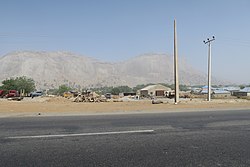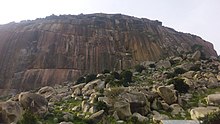world.wikisort.org - Nigeria
Zamfara (Hausa: Jihar Zamfara Fula: Leydi Zamfara 𞤤𞤫𞤴𞤣𞤭 𞤶𞤢𞤥𞤬𞤢𞤪𞤢) is a state in northwestern Nigeria. The capital of Zamfara state is Gusau and its current Governor is Bello Matawalle. Until 1996, the area was part of Sokoto State.
Zamfara جهار زمفر | |
|---|---|
State | |
 | |
| Nicknames: Farming is Our Pride | |
 Location of Zamfara State in Nigeria | |
| Coordinates: 12°10′N 6°15′E | |
| Country | |
| Date created | 1 October 1996 |
| Capital | Gusau |
| Government | |
| • Body | Government of Zamfara State |
| • Governor (List) | Bello Mohammed Matawalle (APC) |
| • Deputy Governor | Hassan Muhammed Gusau (APC) |
| • Legislature | Zamfara State House of Assembly |
| • Senators | C: Vacant N: Sahabi Alhaji Yaú (APC) W: Lawal Hassan Anka (APC) |
| • Representatives | List |
| Area | |
| • Total | 39,762 km2 (15,352 sq mi) |
| • Rank | 7th of 36 |
| Population (2021 Census) | |
| • Total | 9,278,873[1] |
| • Estimate (2011) | 9,838,160 |
| • Rank | 11th of 36 |
| Demonym | Zamfaran |
| GDP (PPP) | |
| • Year | 2007 |
| • Total | $4.12 billion[2] |
| • Per capita | $1,237[2] |
| Time zone | UTC+01 (WAT) |
| ISO 3166 code | NG-ZA |
| HDI (2018) | 0.415[3] low · 32nd of 37 |

Zamfara is a densely populated area with the Hausa and Fulani peoples. The Zamfarawa mainly in Anka, Gummi, Bukkuyum and Talata Mafara Local Governments areas. Gobirawa populated Shinkafi Local Government.[4] Gobirawa actually migrated from the Gobir Kingdom. Burmawa are found in Bakura and Fulani peopled Bungudu, Maradun, Gusau and are scattered all over the State. In Chafe, Bungudu and Maru, most are mainly Katsinawa, Garewatawa and Hadejawa. While, Alibawa people are located at Kaura Namoda and Zurmi, the Alawan Shehu Usmanu Fulani's are found in Birninmagaji.[5]
It is bordered to the north by the Republic of the Niger, to the south by Kaduna State, to the east by Katsina State, and to the west by the states of Sokoto, Kebbi and Niger. It has a population of 9,278,873 according to the 2006 census and contains fourteen local government areas.
History
The people of Zamfara have over the years struggled for autonomy, but it was not until 1996 that the then military administration of the late General Sani Abacha detached the Zamfara State from Sokoto State with an area of 38,418 square kilometres. The first Governor was Jibril Yakubu.[5][failed verification]
The area today called Zamfara state was one of the old states like Kano, Katsina, Gobir, Kabi and Zazzau. The earliest inhabitants of Zamfara were said to have been hunters and giants.[6] They established their first settlement at Dutsi, which was the first capital of Zamfara. It extends up to the bend of River Rima to the north west and River Ka in the south west. Zamfara Kingdom was established in the 11th century and flourished up to 16th century as a city-state. Its capital has shifted with the fortunes of the kingdom from place to place like Dutsi and Birnin Zamfara.
In the first half of the 18th century, its then capital Birnin Zamfara, was destroyed by the Gobir Kingdom and a new capital was established in Anka by the second half of the 19th century. Zamfara had many centers of commerce and scholarship that attracted many scholars like the Yandoto city. It became part of the Sokoto Caliphate after the 1804 jihad by Usman dan Fodio. In fact, Usman Danfodiyo settled in Sabon Gari where Sarkin Zamfara Abarshi had already established a garrison headquarters during the early days of his Jihad as a base from where fought Gobir and Kabi.[7]
At the wake of British colonialism, the emerging town of Gusau became an important commercial and administrative center with road and rail networks passing through it. With the creation of states during the Gowon Administration, Zamfara Kingdom became part of the then North West state and later the Sokoto State.[7]
Climate
The climate condition of Zamfara is tropical with temperatures rising up to 38 °C (100.4 °F) and above between March and May. Rainy season starts in late May to September while the mild season known as Harmattan lasts from December to April. The hottest months in Zamfara are March and April that is just before the first rains. the onset of the rains bring a cooling effect with temperature dropping.[8]
Local Government Areas
Zamfara State consists of fourteen (14) Local Government Areas. They are:
Demographics

Zamfara State is mainly populated by Hausa and Fulani people, with some members of Gwari, Kamuku, Kambari, Dukawa, Bussawa and Zabarma ethnic communities.[9] Others include the Igbo, Yoruba, Kanuri, Nupe and Tiv.
The state capital is an important commercial center with a heterogeneous population of people from all over Nigeria. As in all major towns in Nigeria, all the major towns in Zamfara have a large population of other peoples from different parts of Nigeria.[5]
Languages
Hausa is the official language of the state. Other main languages spoken in Zamfara are English, French, Fulfulde, Arabic; minority populations also speak languages like: Yoruba and Igbo.
The Kainji languages C'Lela and Gwamhi-Wuri are spoken in Gummi LGA. Ut-Ma'in is also spoken in the state and in Kebbe, Sokoto State.[10]
Economy


Agriculture and gold mining are the state's main occupations and the central source of income. Irrigation is required for cereals and legumes, hence the slogan "farming is our pride".[11]
Over 80 percent of the population is engaged in agriculture. Major products include millet, guinea corn, maize, rice, groundnut, cotton, tobacco and beans.[12] The State is known as farming is our pride because Agriculture provides foodstuff, raw materials and employment opportunities to young people in the State.[5]
Education
A list of tertiary institutions in Zamfara state include:
- Federal Polytechnic, Kaura-Namoda[13]
- Zamfara State University[14]
- Federal University Gusau[15]
- Federal College of Education (Technical), Gusau
- Zamfara State College of Art and Sciences, Gusau
- Zamfara State College Of Education, Maru
Incidents
In 2009, gold mining became a greater source of income in Zamfara State as worldwide gold prices rose dramatically.[16] High concentrations of lead in the ore from which gold was being extracted led to a lead poisoning outbreak in the state, requiring national and international intervention to remediate affected areas and provide medical care to children with severe lead poisoning.[4]
Bandit attacks
Zamfara is known to experience several recent attacks from bandits. Some among them are:
On 26 February 2021, 279 girls were abducted from their boarding school located in Jangebe, Zamfara during the Zamfara kidnapping. They have since been released.[17]
On 11–12 June 2021, motorcycle-riding bandits killed over 53 villagers, mostly farmers.[18]
On 4–6 January 2022, over 200 people were killed by bandits in Zamfara State.[19][20]
Religion
Islam is the principal and major religion of the state. Christianity also has many adherents. The original native religions also remain but they have the fewest followers. These religions are mainly practiced in ancient settlements like Dutsi and Kwatarkwashi. Zamfara was the first state in Nigeria to introduce Sharia law during the tenure of Ahmad Sani Yerima, the former Governor of the state.
Tourism

Zamfara State holds some number of tourist attractions which are of historical or religious importance. These include Jata, an ancient settlement of Zamfara located around the hill with a large cave around where traditional practices were performed.[12]
Notable people

- Aishatu Madawaki
- Bello Matawalle
- Abdul'aziz Abubakar Yari
- Ahmad Sani Yerima
See also
- States of Nigeria
References
- "2021 PHC Priority Tables – NATIONAL POPULATION COMMISSION". population.gov.ng. Archived from the original on 2018-01-14. Retrieved 2017-10-10.
- "C-GIDD (Canback Global Income Distribution Database)". Canback Dangel. Archived from the original on 2012-02-16. Retrieved 2008-08-20.
- "Sub-national HDI - Area Database - Global Data Lab". hdi.globaldatalab.org. Archived from the original on 2018-09-23. Retrieved 2018-09-13.
- "Zamfara State". Nigerian Investment Promotion Commission. 2019-01-09. Retrieved 2022-02-27.
- "Zamfara State of Nigeria :: Nigeria Information & Guide". www.nigeriagalleria.com. Retrieved 2022-02-26.
- "Zamfara Gold Mining Factory". krzysztofpilarczyk.pl. Archived from the original on 2021-06-26. Retrieved 2021-06-26.
- "Zamfara State, Nigeria Genealogy". FamilySearch Wiki. 11 April 2020. Archived from the original on 2021-10-15. Retrieved 2021-06-26.
- Abdu . P.S., K. Swindell (1982). Sokoto State in Maps: An Atlas of physical and Human Resources. Ibadan: Oxford University Press.
- "Nigeria Ethnic Groups|Map". onlinenigeria.com. Archived from the original on 2021-01-26. Retrieved 2021-02-14.
- "Nigeria". Ethnologue (22 ed.). Archived from the original on 2020-02-19. Retrieved 2020-01-10.
- "Zamfara gold mining: Niger Delta seeks amendment of petroleum, mining acts". December 12, 2020. Archived from the original on February 17, 2021. Retrieved March 2, 2021.
- "Zamfara State of Nigeria :: Nigeria Information & Guide". www.nigeriagalleria.com. Archived from the original on 2020-11-07. Retrieved 2021-02-28.
- "Official List of Courses Offered in Federal Polytechnic, Kaura Namoda (FEDPONAM) - Myschool". myschool.ng. Archived from the original on 2021-07-14. Retrieved 2021-07-14.
- "List of All Courses Offered at ZAMSU, Cut Off Mark & Requirements". Eduloaded. 2019-01-14. Archived from the original on 2022-01-13. Retrieved 2021-07-14.
- "List Of FUGUS Courses and Programmes Offered". www.myschoolgist.com. 2020-10-09. Archived from the original on 2021-07-14. Retrieved 2021-07-14.
- Maram Mazen (2012-05-10). "Nigeria Gold Rush Exposes Children to Lead Poisoning - Bloomberg Business". Bloomberg.com. Archived from the original on 2014-10-18. Retrieved 2015-12-17.
- "Nigeria's Zamfara school abduction: More than 300 Nigerian girls missing". BBC News. 2021-02-26. Archived from the original on 2021-02-26. Retrieved 2021-02-28.
- "Gunmen storm villages, kill 53 in Nigeria's Zamfara state". www.aljazeera.com. Retrieved 2022-05-18.
- "At least 200 dead in bandit attacks in northwest Nigeria". Al Jazeera. Archived from the original on 9 January 2022. Retrieved 9 January 2022.
- Nwannah, Ifeanyi (2022-02-26). "Security operatives rescue 7 kidnapped victims in Zamfara". Daily Post Nigeria. Retrieved 2022-02-27.
External links
На других языках
- [en] Zamfara State
[ru] Замфара
Замфара (англ. Zamfara State) — штат в Нигерии, расположенный на северо-западе страны. Площадь штата — 39 762 км². Население — 3 278 873 чел. (2006). Административный центр — город Гусо.Другой контент может иметь иную лицензию. Перед использованием материалов сайта WikiSort.org внимательно изучите правила лицензирования конкретных элементов наполнения сайта.
WikiSort.org - проект по пересортировке и дополнению контента Википедии


